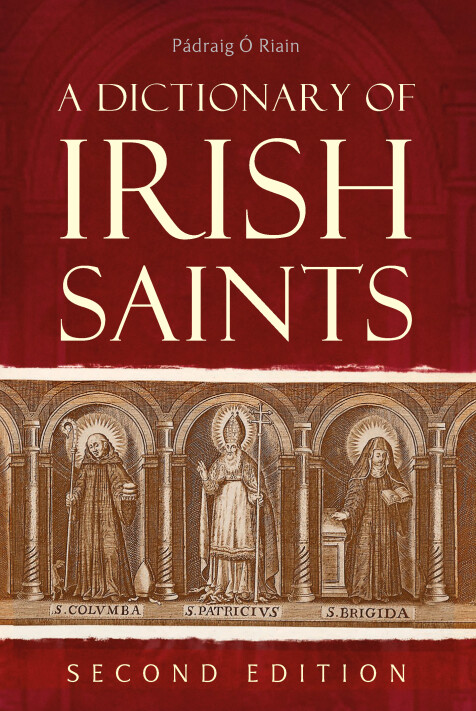A Dictionary of Irish Saints
Second Edition
Pádraig Ó Riain
"My interest in the histories of the Irish saints began as long ago as 1975 with an invitation from the Cork Historical and Archaeological Society to give a lecture on the patron saint of the parish I was born in and the diocese in which I have lived most of my life, Cork’s patron: St Finbarr. Reaction to the lecture, in which I contended the Finbarr’s cult originated at Movilla in North County Down, was lively, to say the least. The various conflicting pedigrees transmitted for Finbarr then inspired me to undertake an edition of the whole corpus of Irish saints’ pedigrees, which was published by the Dublin Institute for Advanced Studies in 1985 under the title Corpus genealogiarum sanctorum Hiberniae (CGSH). My notes on the genealogies, collected in two large manuscript volumes, served as a basis for a large proportion of the entries later presented in the Dictionary. However, due to other commitments, work on the Dictionary was set aside for almost twenty years until after my retirement in 2002. Drafting of entries began in earnest in 2006; a first version was completed by 2009 and, following several re-readings and numerous additions and corrections, the work was finally handed to outside readers during 2010, and subsequently first published by Four Courts in 2011. In the thirteen years since its publication by Four Courts Press in 2011 A dictionary of Irish saints has rarely been far from my desk. Beginning with notes added to an interleaved copy, I assembled a large selection of additional material which was published separately by Four Courts in 2022 in A Supplement to a Dictionary of Irish Saints. The material in the Supplement is incorporated into the Second Edition of the Dictionary.
Copies of the Second Edition arrived today and I would like to congratulate the Press on the quality of the production, from cover to cover! The change in colour of the cover sets it off beautifully from the First Edition, as does the specification of Second Edition on the cover. Professor Pádraig Ó Riain
“The old romantic view of Ireland as the ‘isle of saints and scholars’ is no exaggeration as Professor Pádraig Ó Riain expertly demonstrates in the second edition of his fascinating Dictionary of Irish Saints. It is a wonderfully-written book that will be an incredibly valuable resource to a wide audience for generations to come ... The main contents of the book are, of course, the saints themselves. Inevitably, the better-known saints such as Patrick of Armagh, Brigit of Kildare, Colum Cille of Iona, Scotland, Íde of Killeedy, Limerick and Moninne of Killevy, Armagh are the subjects of the largest entries in the book ... The accounts of these and all the other saints included in the Dictionary reveal much about the complexity of ancient and medieval Irish society … [the book] brims with miraculous events … Ó Riain’s meticulous research presents a vast array of Irish saints, many with multiple feast days, alternative names, and associated churches, monastic foundations and other cult sites spread over a wide geographical area ... The miracles with which they were associated, the churches they founded and the placenames that remember them resonate with Irish people today. Virtually every corner of Ireland is connected with the ancient past through association with saints, whether through a placename, ecclesiastical site, geographical feature, or personal name. In essence, Ireland’s very identity is interwoven with its saints … A Dictionary of Irish Saints is not a book to be read in one sitting. It is a resource to which to return time and again and an exploratory guide to understanding Ireland’s past and present, its people and the land. And yet it is a genuinely great read. It is not possible to do full justice to Pádraig Ó Riain’s monumental achievement in such a brief review, but every library, community heritage group and, dare it be said, household, should have a copy of this superb book.” Dr Chris Doyle, the Irish Times
“[A]n outstanding contribution to the study of early Irish saints and their cults … For students of early Irish literature, therefore, as well as historians, Ó Riain’s Dictionary will form part of that select group of ‘indispensable books” Thomas Charles-Edwards, Irish Historical Studies
“[A] simply splendid book, which cannot be recommended highly enough to readers, for it provides an almost complete Irish hagiography” Peter Costello, The Irish Catholic
“This dictionary, the work of more than 40 years, is an extraordinary achievement … This is an important research tool for specialist libraries and for scholars of the vast heritage of Ireland. Highly Recommended” E.J. Kealey, Choice
“It is difficult to overemphasise the importance and scope of this extraordinary piece of scholarship. Simply indispensable” Brendan Scott, Breifne

